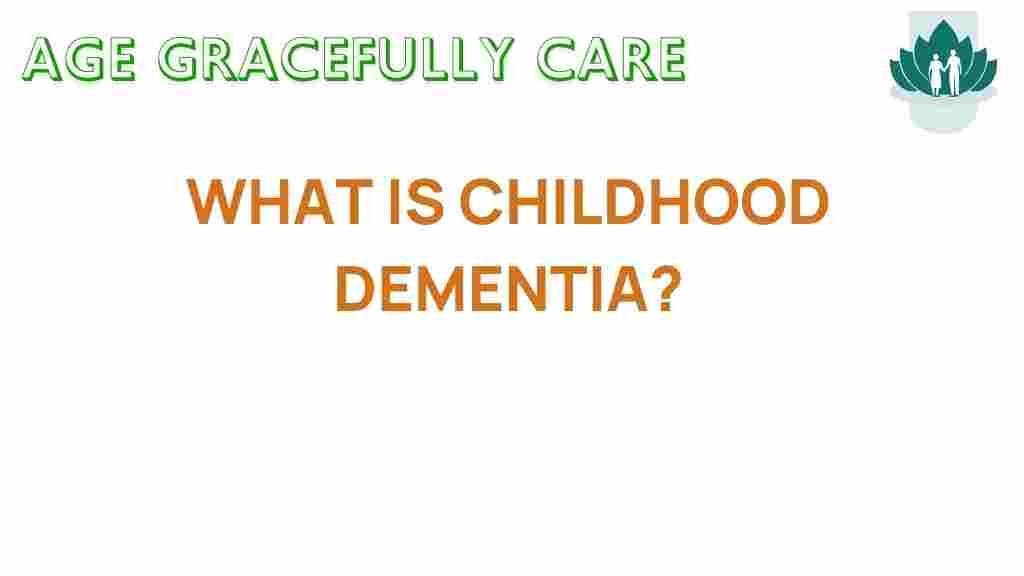Unveiling the Mysteries of Childhood Dementia
Childhood dementia, though less common than its adult counterpart, is a heartbreaking reality that affects families across the globe. Early onset dementia can manifest in various forms and is often associated with neurological disorders. Understanding the symptoms, diagnosis, caregiving, and available support is crucial for families navigating this challenging condition. In this article, we will delve into the complexities of childhood dementia, discuss its various aspects, and provide insights on how to manage and support affected children.
Understanding Childhood Dementia
Childhood dementia is a term that describes a range of neurodegenerative conditions that lead to cognitive decline in children. Unlike typical childhood developmental disorders, childhood dementia involves a progressive deterioration of cognitive functions that can significantly impact a child’s quality of life. Early onset dementia in children can stem from various causes, including genetic factors, metabolic disorders, and other neurological conditions.
Causes of Childhood Dementia
There are several causes of childhood dementia. Understanding these causes can help in early diagnosis and intervention:
- Genetic Disorders: Certain inherited conditions, such as Batten disease, can lead to childhood dementia.
- Metabolic Disorders: Disorders that affect the body’s metabolism can cause neurological damage over time.
- Neurological Disorders: Conditions like cerebral palsy and other developmental disabilities can contribute to cognitive decline.
- Infections: Severe infections or autoimmune diseases that affect the brain can also lead to dementia-like symptoms.
Recognizing the Symptoms
Identifying symptoms of childhood dementia early on can make a significant difference in management and care. The symptoms can vary widely, but common signs include:
- Cognitive Decline: Problems with memory, attention, and decision-making.
- Behavioral Changes: Increased irritability, anxiety, or mood swings.
- Physical Symptoms: Issues such as difficulty with coordination, walking, or fine motor skills.
- Social Withdrawal: Loss of interest in social interactions or activities previously enjoyed.
Diagnosing Childhood Dementia
Diagnosing childhood dementia is a multifaceted process that often involves a team of healthcare professionals. The following steps are typically followed:
Step-by-Step Diagnostic Process
- Medical History: A thorough review of the child’s medical history, including family health history, is crucial.
- Physical Examination: A comprehensive physical and neurological examination to assess symptoms.
- Neurological Tests: Imaging tests such as MRI or CT scans may be conducted to evaluate brain structure.
- Psychological Assessment: Cognitive and behavioral assessments to gauge the child’s mental state.
- Genetic Testing: In cases where a genetic disorder is suspected, genetic testing may be recommended.
Early and accurate diagnosis is essential in managing childhood dementia effectively. If you suspect that your child may be experiencing symptoms, consult a healthcare professional as soon as possible.
Caregiving for Children with Dementia
Caregiving for a child with dementia presents unique challenges. It requires patience, understanding, and a strong support system. Here are some tips for caregivers:
Tips for Effective Caregiving
- Establish Routines: Children with dementia often benefit from structured routines that provide predictability.
- Communicate Clearly: Use simple language and clear instructions to help your child understand.
- Encourage Engagement: Adapt activities to your child’s abilities to keep them engaged and socially active.
- Be Patient: Understand that cognitive decline can be frustrating for both the child and the caregiver.
- Seek Support: Connect with support groups and other families facing similar challenges.
Raising Awareness About Childhood Dementia
Raising awareness about childhood dementia is vital for early diagnosis and improved outcomes. Here are some ways to promote awareness:
Strategies for Awareness
- Education: Informing yourself and others about childhood dementia can help in recognizing symptoms early.
- Community Engagement: Participate in local events or campaigns that focus on raising awareness about neurological disorders.
- Social Media: Use platforms to share stories and information regarding childhood dementia.
By spreading awareness, you can help others understand the realities of childhood dementia and the importance of early recognition and intervention.
Treatment and Support Options
Currently, there is no cure for childhood dementia, but various treatment options and support systems are available to help manage symptoms and improve quality of life.
Available Treatments
The treatment approaches may include:
- Medications: Certain medications can help manage symptoms such as anxiety or behavioral changes.
- Therapies: Occupational therapy, speech therapy, and behavioral therapy can be beneficial.
- Diet and Nutrition: A balanced diet tailored to the child’s needs can support overall health.
Support Resources
Families coping with childhood dementia can find support through various resources:
- National Alliance for Caregiving – Provides resources and support for caregivers.
- Support Groups: Joining a support group can provide emotional support and practical advice.
- Professional Counseling: Engaging with a mental health professional can help caregivers manage stress.
Conclusion
Childhood dementia is a complex and often misunderstood condition that requires awareness, understanding, and compassion. By recognizing the symptoms, seeking timely diagnosis, and providing effective caregiving, families can navigate this challenging journey. It is crucial to foster awareness and support for affected families, as well as to advocate for research into treatment options. Together, we can make a difference in the lives of children facing childhood dementia and their families.
For more information about neurological disorders and support, visit this resource. Remember, you are not alone in this journey.
This article is in the category Health and created by AgeGracefullyCare Team
